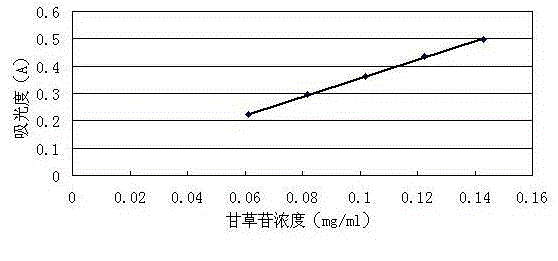Method for extracting liquorice flavonoids from liquorice residue
A technology of licorice flavonoids and licorice residue is applied in the directions of pharmaceutical formulations, medical preparations containing active ingredients, food science, etc., and achieves the effects of cost safety, non-toxicity, improved yield, and simple process operation.
- Summary
- Abstract
- Description
- Claims
- Application Information
AI Technical Summary
Problems solved by technology
Method used
Image
Examples
Embodiment 1
[0024] 1. Extract total flavonoids from licorice
[0025] (1) Do the preparatory work first, that is, dry the licorice residue and crush it into a coarse powder; take an equal amount of cellulase and pectinase and add water to prepare a compound enzyme solution with a concentration of 0.1%; take chitosan 0.8g, added to 80mL concentration of 1% acetic acid solution to make a chitosan colloid solution with a chitosan concentration of 1%, and set aside; take 4g of 101 fruit juice clarifier, add it to 80mL distilled water to make a concentration of 101 fruit juice clarifier It is 5% aqueous solution of 101 fruit juice clarifier, and it is set aside.
[0026] (2) Take 1000g of licorice residue coarse powder and add it to the prepared compound enzyme solution. ) after 1.0 h of treatment, the temperature was raised rapidly to 90°C, kept for 10 min to inactivate the enzyme, filtered, and the filtrate was concentrated under reduced pressure to a relative density of 1.05 (60°C) to obta...
Embodiment 2
[0035](1) Dry the licorice residue and crush it into a coarse powder; take an equal amount of cellulase and pectinase and add water to prepare a compound enzyme solution with a concentration of 0.15%; prepare a chitosan concentration of 1% chitosan colloid solution and 101 fruit juice clarifying agent concentration are 5% 101 fruit juice clarifying agent aqueous solution, standby.
[0036] (2) Take 1000g of licorice residue coarse powder, add it to the prepared compound enzyme solution, the amount added is 1g licorice residue / 25ml compound enzyme solution, then adjust the pH value of the solution to 4.5, and then ultrasonicate at 40°C (50KHZ, 160W ) after 1.0 h of treatment, the temperature was raised rapidly to 90°C, kept for 10 min to inactivate the enzyme, filtered, and the filtrate was concentrated under reduced pressure to a relative density of 1.05 (60°C) to obtain a concentrate.
[0037] (3) At 60°C, add 80mL of chitosan colloid solution to the 1000ml concentrated solut...
Embodiment 3
[0041] (1) Dry the licorice residue and crush it into a coarse powder; take an equal amount of cellulase and pectinase and add water to prepare a compound enzyme solution with a concentration of 0.05%; prepare the chitosan concentration by the same method as in Example 1 1% chitosan colloid solution and 101 fruit juice clarifying agent concentration are 5% 101 fruit juice clarifying agent aqueous solution, standby.
[0042] (2) Take 1000g of licorice residue coarse powder and add it to the prepared compound enzyme solution. ) after 1.5 hours of treatment, the temperature was rapidly raised to 90°C, kept for 10 minutes to inactivate the enzyme, filtered, and the filtrate was concentrated under reduced pressure to a relative density of 1.05 (60°C) to obtain a concentrate.
[0043] (3) At 60°C, add 80mL of chitosan colloid solution to the 1000ml concentrated solution obtained in the previous step, stir well, then add 80mL of 101 juice clarifier aqueous solution, stir well, let st...
PUM
 Login to View More
Login to View More Abstract
Description
Claims
Application Information
 Login to View More
Login to View More - R&D
- Intellectual Property
- Life Sciences
- Materials
- Tech Scout
- Unparalleled Data Quality
- Higher Quality Content
- 60% Fewer Hallucinations
Browse by: Latest US Patents, China's latest patents, Technical Efficacy Thesaurus, Application Domain, Technology Topic, Popular Technical Reports.
© 2025 PatSnap. All rights reserved.Legal|Privacy policy|Modern Slavery Act Transparency Statement|Sitemap|About US| Contact US: help@patsnap.com

